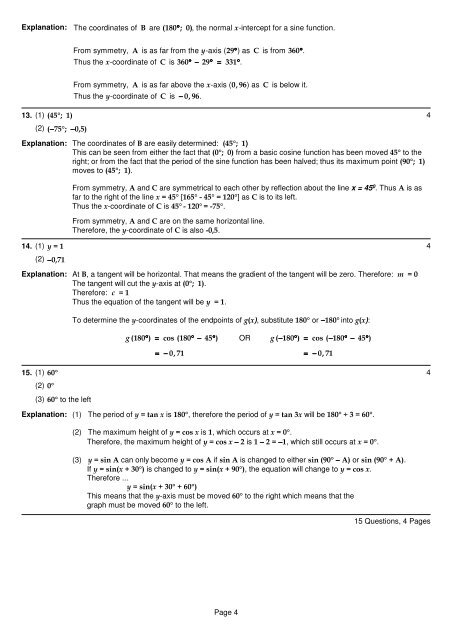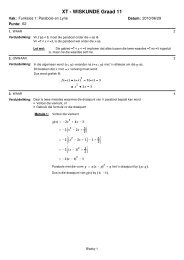XT â MATHS Grade 11 â Trigonometry â Graphs Memo
XT â MATHS Grade 11 â Trigonometry â Graphs Memo
XT â MATHS Grade 11 â Trigonometry â Graphs Memo
Create successful ePaper yourself
Turn your PDF publications into a flip-book with our unique Google optimized e-Paper software.
Explanation:The coordinates of B are (180 ° ; 0) , the normal x-intercept for a sine function.From symmetry, A is as far from the y-axis ( 29 ° ) as C is from 360°.Thus the x-coordinate of C is 360 ° − 29 ° = 331°.From symmetry, A is as far above the x-axis ( 0, 96) as C is below it.Thus the y-coordinate of C is − 0, 96.13. (1) (45°; 1)4(2) (−75°; −0,5)Explanation:The coordinates of B are easily determined: (45°; 1)This can be seen from either the fact that (0°; 0) from a basic cosine function has been moved 45° to theright; or from the fact that the period of the sine function has been halved; thus its maximum point (90°; 1)moves to (45°; 1).From symmetry, A and C are symmetrical to each other by reflection about the line x = 45 0 . Thus A is asfar to the right of the line x = 45° [165° - 45° = 120°] as C is to its left.Thus the x-coordinate of C is 45° - 120° = -75°.From symmetry, A and C are on the same horizontal line.Therefore, the y-coordinate of C is also -0,5.14. (1) y = 14(2) −0,71Explanation:At B, a tangent will be horizontal. That means the gradient of the tangent will be zero. Therefore: m = 0The tangent will cut the y-axis at (0°; 1).Therefore: c = 1Thus the equation of the tangent will be y = 1.To determine the y-coordinates of the endpoints of g(x), substitute 180° or −180° into g(x):g (180 ° ) = cos (180 ° − 45 ° ) OR g ( − 180 ° ) = cos ( − 180 ° − 45 °)= − 0, 71 = −0, 7<strong>11</strong>5. (1) 60°4(2) 0°(3) 60° to the leftExplanation:(1) The period of y = tan x is 180°, therefore the period of y = tan 3x will be 180° ÷ 3 = 60°.(2) The maximum height of y = cos x is 1, which occurs at x = 0°.Therefore, the maximum height of y = cos x − 2 is 1 − 2 = −1, which still occurs at x = 0°.(3) y = sin A can only become y = cos A if sin A is changed to either sin (90° − A) or sin (90° + A).If y = sin(x + 30°) is changed to y = sin(x + 90°), the equation will change to y = cos x.Therefore ...y = sin(x + 30° + 60°)This means that the y-axis must be moved 60° to the right which means that thegraph must be moved 60° to the left.15 Questions, 4 PagesPage 4
















